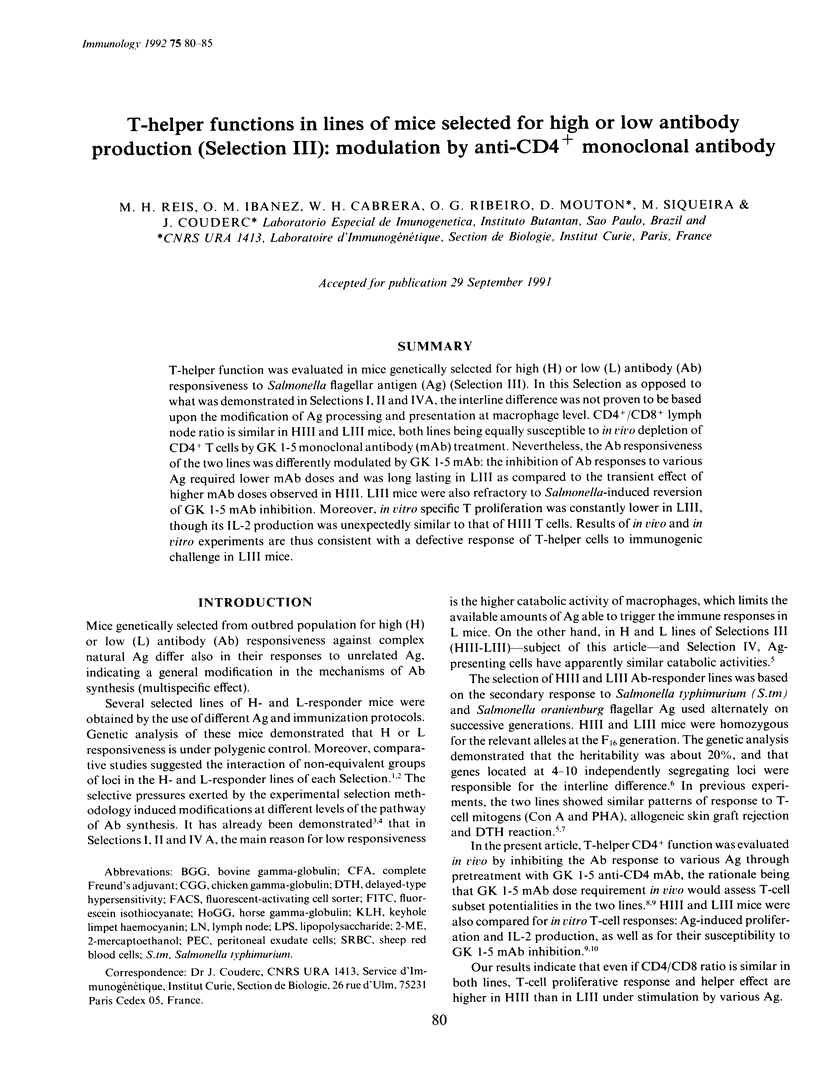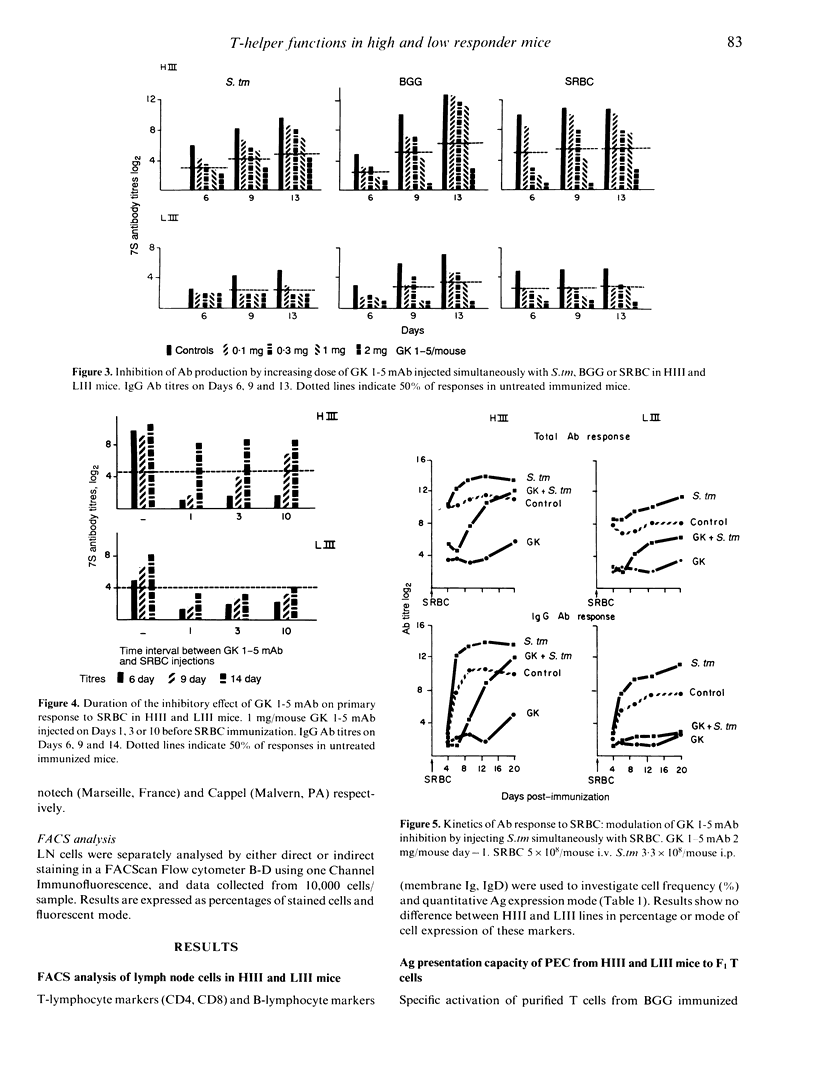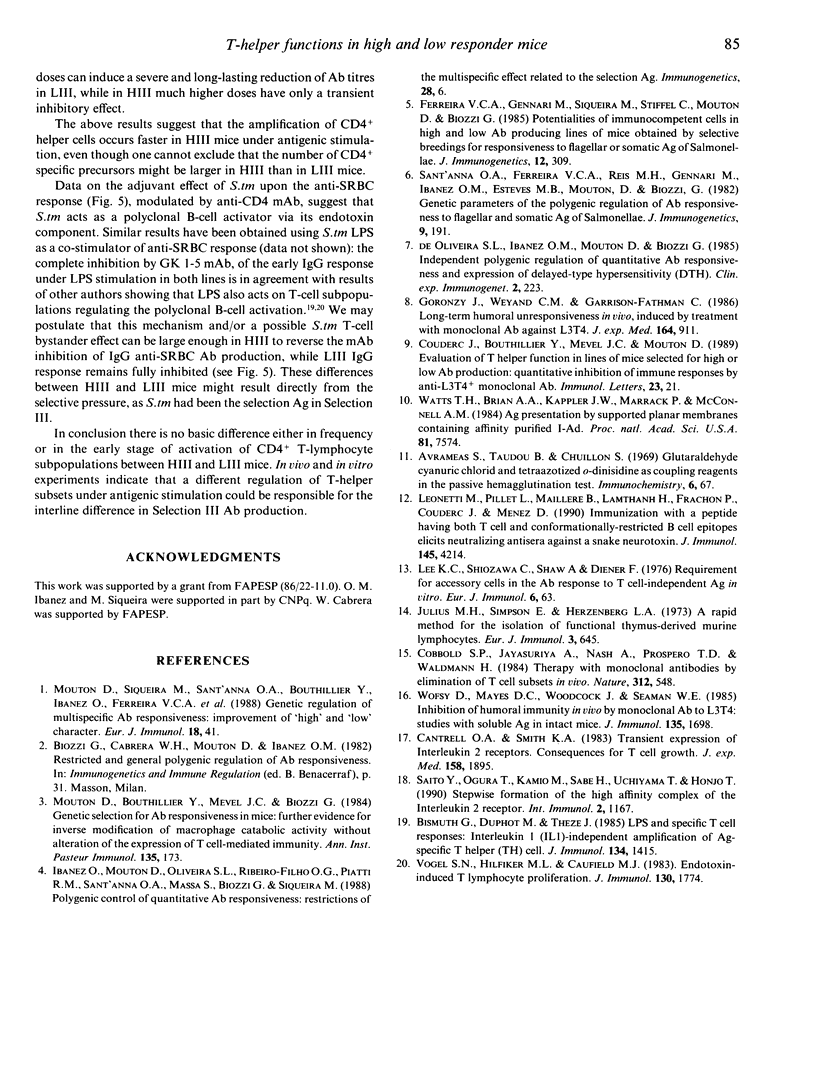Abstract
T-helper function was evaluated in mice genetically selected for high (H) or low (L) antibody (Ab) responsiveness to Salmonella flagellar antigen (Ag) (Selection III). In this Selection as opposed to what was demonstrated in Selections I, II and IVA, the interline difference was not proven to be based upon the modification of Ag processing and presentation at macrophage level. CD4+/CD8+ lymph node ratio is similar in HIII and LIII mice, both lines being equally susceptible to in vivo depletion of CD4+ T cells by GK 1-5 monoclonal antibody (mAb) treatment. Nevertheless, the Ab responsiveness of the two lines was differently modulated by GK 1-5 mAb: the inhibition of Ab responses to various Ag required lower mAb doses and was long lasting in LIII as compared to the transient effect of higher mAb doses observed in HIII. LIII mice were also refractory to Salmonella-induced reversion of GK 1-5 mAb inhibition. Moreover, in vitro specific I proliferation was constantly lower in LIII, though its IL-2 production was unexpectedly similar to that of HIII T cells. Results of in vivo and in vitro experiments are thus consistent with a defective response of T-helper cells to immunogenic challenge in LIII mice.
Full text
PDF





Selected References
These references are in PubMed. This may not be the complete list of references from this article.
- Avrameas S., Taudou B., Chuilon S. Glutaraldehyde, cyanuric chloride and tetrazotized O-dianisidine as coupling reagents in the passive hemagglutination test. Immunochemistry. 1969 Jan;6(1):67–76. doi: 10.1016/0019-2791(69)90179-7. [DOI] [PubMed] [Google Scholar]
- Bismuth G., Duphot M., Theze J. LPS and specific T cell responses: interleukin 1 (IL 1)-independent amplification of antigen-specific T helper (TH) cell proliferation. J Immunol. 1985 Mar;134(3):1415–1421. [PubMed] [Google Scholar]
- Cantrell D. A., Smith K. A. Transient expression of interleukin 2 receptors. Consequences for T cell growth. J Exp Med. 1983 Dec 1;158(6):1895–1911. doi: 10.1084/jem.158.6.1895. [DOI] [PMC free article] [PubMed] [Google Scholar]
- Cobbold S. P., Jayasuriya A., Nash A., Prospero T. D., Waldmann H. Therapy with monoclonal antibodies by elimination of T-cell subsets in vivo. Nature. 1984 Dec 6;312(5994):548–551. doi: 10.1038/312548a0. [DOI] [PubMed] [Google Scholar]
- Couderc J., Bouthillier Y., Mevel J. C., Mouton D. Evaluation of T helper function in lines of mice selected for high or low antibody production: quantitative inhibition of immune responses by anti-L3T4+ monoclonal antibody. Immunol Lett. 1989 Nov;23(1):21–26. doi: 10.1016/0165-2478(89)90149-1. [DOI] [PubMed] [Google Scholar]
- Ferreira V., Gennari M., Reis M. H., Siqueira M., Stiffel C., Mouton D., Biozzi G. Potentialities of immunocompetent cells in high and low antibody-producing lines of mice obtained by selective breedings for responsiveness to flagellar or somatic antigens of Salmonellae. J Immunogenet. 1985 Dec;12(6):309–319. [PubMed] [Google Scholar]
- Goronzy J., Weyand C. M., Fathman C. G. Long-term humoral unresponsiveness in vivo, induced by treatment with monoclonal antibody against L3T4. J Exp Med. 1986 Sep 1;164(3):911–925. doi: 10.1084/jem.164.3.911. [DOI] [PMC free article] [PubMed] [Google Scholar]
- Julius M. H., Simpson E., Herzenberg L. A. A rapid method for the isolation of functional thymus-derived murine lymphocytes. Eur J Immunol. 1973 Oct;3(10):645–649. doi: 10.1002/eji.1830031011. [DOI] [PubMed] [Google Scholar]
- Lee K. C., Shiozawa C., Shaw A., Diener E. Requirement for accessory cells in the antibody response to T cell-independent antigens in vitro. Eur J Immunol. 1976 Jan;6(1):63–68. doi: 10.1002/eji.1830060114. [DOI] [PubMed] [Google Scholar]
- Léonetti M., Pillet L., Maillère B., Lamthanh H., Frachon P., Couderc J., Ménez A. Immunization with a peptide having both T cell and conformationally restricted B cell epitopes elicits neutralizing antisera against a snake neurotoxin. J Immunol. 1990 Dec 15;145(12):4214–4221. [PubMed] [Google Scholar]
- Mouton D., Bouthillier Y., Mevel J. C., Biozzi G. Genetic selection for antibody responsiveness in mice: further evidence for inverse modification of macrophage catabolic activity without alteration of the expression of T-cell-mediated immunity. Ann Immunol (Paris) 1984 Sep-Oct;135D(2):173–186. doi: 10.1016/s0769-2625(84)81109-5. [DOI] [PubMed] [Google Scholar]
- Saito Y., Ogura T., Kamio M., Sabe H., Uchiyama T., Honjo T. Stepwise formation of the high-affinity complex of the interleukin 2 receptor. Int Immunol. 1990;2(12):1167–1177. doi: 10.1093/intimm/2.12.1167. [DOI] [PubMed] [Google Scholar]
- Sant'Anna O. A., Ferreira V. C., Reis M. H., Gennari M., Ibañez O. M., Esteves M. B., Mouton D., Biozzi G. Genetic parameters of the polygenic regulation of antibody responsiveness to flagellar and somatic antigens of salmonellae. J Immunogenet. 1982 Jun;9(3):191–205. doi: 10.1111/j.1744-313x.1982.tb00791.x. [DOI] [PubMed] [Google Scholar]
- Vogel S. N., Hilfiker M. L., Caulfield M. J. Endotoxin-induced T lymphocyte proliferation. J Immunol. 1983 Apr;130(4):1774–1779. [PubMed] [Google Scholar]
- Wofsy D., Mayes D. C., Woodcock J., Seaman W. E. Inhibition of humoral immunity in vivo by monoclonal antibody to L3T4: studies with soluble antigens in intact mice. J Immunol. 1985 Sep;135(3):1698–1701. [PubMed] [Google Scholar]
- de Oliveira S. L., Ibanez O. M., Mouton D., Sant'Anna O. A., Siqueira M., Biozzi G. Independent polygenic regulation of quantitative antibody responsiveness and expression of delayed-type hypersensitivity (DTH). Exp Clin Immunogenet. 1985;2(4):223–233. [PubMed] [Google Scholar]


